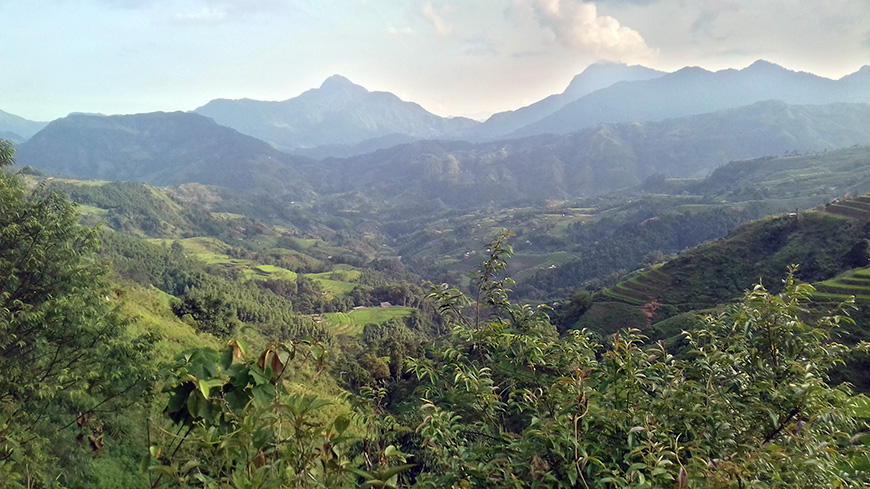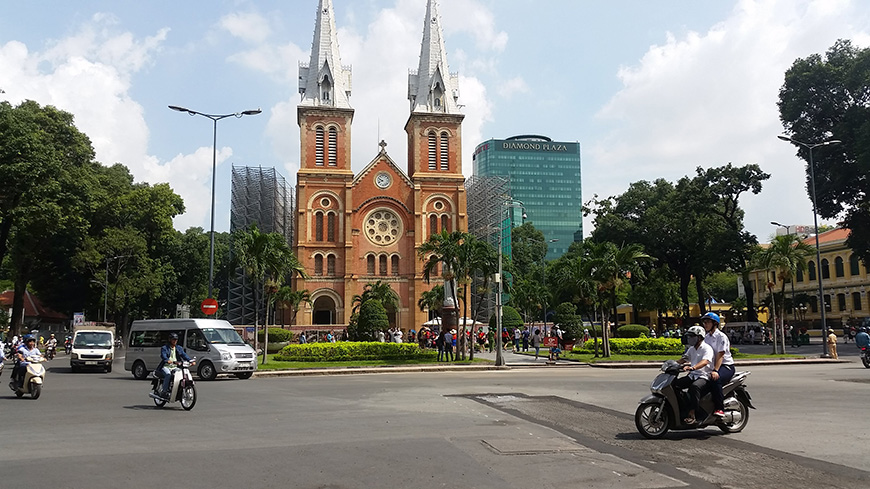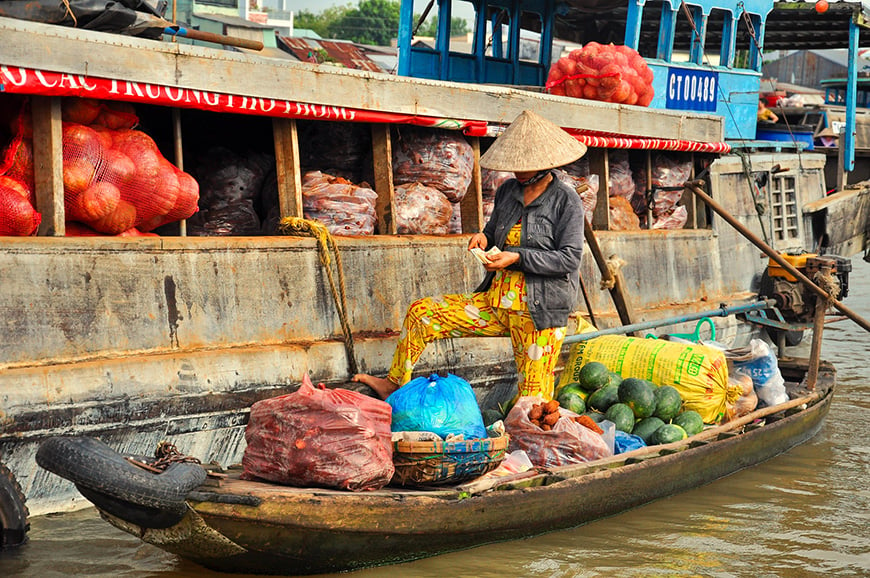A land of a thousand and one contrasts
A true kaleidoscope of landscapes, cultures, and history, Vietnam is a country of astonishing richness. Its unique S-shape, stretching along the East Sea, outlines a "dragon with three faces," where three distinct regions, each with its own character, are shaped by a unique climate and geography. The North, the historical heart, is home to high mountains and the Red River Delta. The Center is a narrow coastal strip, bordered by the Annamite mountain range and long beaches. Finally, the South is a flat, tropical region dominated by the lush Mekong Delta, nicknamed the country's "rice basket".
 Peacefull landscapes of the "terrestrial Ha Long Bay" - Mr Linh's Adventures Team
Peacefull landscapes of the "terrestrial Ha Long Bay" - Mr Linh's Adventures TeamThe North: Vietnam's millennial soul
The North embodies the historical soul and spiritual heart of Vietnam.
It's the region of ancestral traditions, magnificent landscapes, and a millennial heritage. Here, history isn't a distant memory but a presence that permeates the character of the places and their people.
 The Temple of Literature : Vietnam’s long-standing reverence for education - Mr Linh's adventures
The Temple of Literature : Vietnam’s long-standing reverence for education - Mr Linh's adventuresHanoi, the millennial capital
Hanoi is a city where history coexists with modern dynamism. At its heart beats the Old Quarter with its "36 streets" of artisan guilds and bustling markets. This is where you'll find the serene Hoan Kiem Lake, the impressive Ho Chi Minh Mausoleum, the elegant One Pillar Pagoda, and the Temple of Literature, which was the country's first university, founded in 1070.
Ha Long bay, the descending dragon's kingdom
Ha Long bay is a
UNESCO World Heritage natural wonder, famous for its thousands of limestone karsts and strangely shaped islets that emerge from the emerald waters. For a more peaceful experience, explore the
bays of Lan Ha or Bai Tu Long, which offer similar landscapes but with fewer crowds. The best way to explore these bays is undoubtedly a cruise, which can last a day or include a night (or more!) aboard a traditional junk. While a traditional junk cruise is the best way to discover these landscapes, don't forget to try kayaking to weave between the islets. Visiting the caves, like the famous Surprise Cave, is another memorable experience, with its stalagmites and stalactites highlighted by light displays.
Did you know? Vietnamese mythology says that "Ha Long" (the descending dragon into the sea) spat out pearls that turned into rocks to defend the country against invaders.
 Lan Ha Bay, a true paradise for nature enthusiasts - Mr Linh's Adventures
Lan Ha Bay, a true paradise for nature enthusiasts - Mr Linh's AdventuresMountain treasures and northern flavors
The northern inland is an adventurer's paradise. Destinations like
Sapa,
Mu Cang Chai,
Hoang Su Phi, and
Ha Giang are famous for their spectacular terraced rice fields that stretch as far as the eye can see. It's the perfect place to hike and meet ethnic minorities like the Hmong or Dao. Don't miss the "
terrestrial Ha Long Bay" in Ninh Binh, also a
UNESCO site, with its karst formations rising from flooded rice paddies.
The Northwest offers another kind of beauty, wilder and more historical. Places like
Dien Bien Phu are steeped in history, while
Mai Chau and
Pu Luong are perfect for immersing yourself in rural life, with their green valleys and houses on stilts. You can bike through the fields, stay with locals, and discover the culture of the Thai and Muong ethnic groups.
Northern cuisine is characterized by light and balanced flavors. Phở, Vietnam's national dish, is prepared here with a flavorful broth and fewer garnishes than in the South to preserve its subtlety. Don't leave without tasting Bún chả, rice vermicelli with grilled pork, made famous by President Barack Obama's visit to Hanoi.
 Hoang Su Phi is famous for its breathtaking views - Mr Linh's Adventures Team
Hoang Su Phi is famous for its breathtaking views - Mr Linh's Adventures TeamThe Center: A bridge between tradition and modernity
The Center of Vietnam is the very essence of a country in transition, a place where imperial heritage meets modernity and recent history has left indelible marks.
It's the region of the poetic elegance of
Hue, the timeless charm of
Hoi An, and the effervescent dynamism of
Da Nang. This region acts as a bridge between the country's two deltas, symbolized by the famous
Hai Van Pass. One could almost say its inhabitants reflect this geography: the "North-Central," from Hue, adopts a more reserved and formal temperament similar to the Northerners, while the "South-Central," from Da Nang southward, shows a greater openness and the pragmatism of the Southerners.
 Tu Duc's Mausoleum - Hue - Mr Linh's Adventures
Tu Duc's Mausoleum - Hue - Mr Linh's AdventuresHué, the imperial city
Hue, the former capital of the Nguyen dynasty from 1802 to 1945, was the first Vietnamese cultural site classified as a
UNESCO World Heritage site in 1993. Located on the banks of the Perfume River, the city is a concentration of poetry and elegance. The main site is the Imperial City, a vast compound with a perimeter of over 10 kilometers, inspired by the Forbidden City in Beijing. There you'll find the Forbidden Purple City, once reserved for the emperor and his family, as well as palaces, temples, and gardens. Not far away, along the river, stand the majestic mausoleums of the emperors and the iconic Thien Mu Pagoda. A symbol of resilience, Hue was largely destroyed during the 1968 Tet Offensive but has been rebuilt to become a symbol of peace.
 Chinese Assembly Hall- Ancient town of Hoi An - Mr Linh's Adventures Team
Chinese Assembly Hall- Ancient town of Hoi An - Mr Linh's Adventures TeamHoi An, the city of lanterns
This ancient merchant port, now a
UNESCO site, is a living museum. Its unique architecture is a blend of Vietnamese, Chinese, European, and Japanese influences. Hoi An is most famous for its thousands of traditional lanterns that light up at nightfall, transforming the city into a magical spectacle. Travelers love getting lost in its alleys, admiring the emblematic Japanese Bridge, and learning how to make lanterns. The surrounding countryside, dotted with fields and artisan villages, is ideal for a bicycle exploration.
Other discoveries and central cuisine
Just a few kilometers from Hoi An is the My Son Sanctuary, another UNESCO site. This complex of Hindu Cham temples is compared to the greatest archaeological sites in Southeast Asia like Angkor Wat in Cambodia. Further north, the city of Da Nang, considered the most livable in Vietnam, serves as a starting point for excursions to the Golden Bridge in Ba Na Hills, Lady Buddha, or the Dragon Bridge, which breathes fire on weekends.
For those seeking unspoiled seaside destinations, two cities stand out. Quy Nhon is a coastal gem that offers fine sandy beaches, crystal-clear waters, and a peaceful atmosphere. It's the perfect place to relax away from the crowds. For an even more intimate and secret experience, head to Vinh Hy Bay, a true preserved paradise with coral reefs and wild nature that will enchant lovers of tranquility and diving.
Central cuisine is distinguished by its spicy character, richness, and the complexity of its flavors. Bún Bò Huế, a spicy beef and pork noodle soup, is much bolder than the Phở from the North. In Hoi An, don't miss trying Cao Lầu, a unique dish with thick noodles made, according to legend, from a local spring water source. The local version of the crepe, Bánh khoái, is also a specialty of Hue, smaller than the one from the South and served with a delicious peanut sauce.
 Notre-Dame de Saigon - Ho Chi Minh-City - Mr Linh's Adventures Team
Notre-Dame de Saigon - Ho Chi Minh-City - Mr Linh's Adventures TeamThe South: dynamism and tropical flavors
The South embodies Vietnam's energy and optimism, with an ever-present tropical nature. The mindset here is more open and pragmatic, which is reflected in the vibrancy of Ho Chi Minh City.
Ho Chi Minh City, modern elegance
Formerly Saigon, it is the country's largest and most bustling city. The megalopolis's architecture is a fascinating mix of iconic colonial monuments, like Notre-Dame Cathedral and the Central Post Office, and modern skyscrapers like the Bitexco Tower or Landmark 81.
But the poignant vestiges of the Vietnam War are not far away. Seventy kilometers from the city, the Cu Chi Tunnels, an underground system of over 250 kilometers, bear witness to the ingenuity and resilience of the Vietnamese people. In the city center, the War Remnants Museum is the most important and moving in the country, showcasing documents and photos that reveal the atrocities of the conflict and the consequences of Agent Orange.
 Floating Market - Mekong Delta - Mr Linh's Adventures
Floating Market - Mekong Delta - Mr Linh's Adventures The Mekong Delta and life on the water
Nicknamed the "rice basket," the
Mekong Delta is an aquatic world where life is organized on the water. This is where you'll find the famous floating markets like the one in
Cai Rang. Travelers are encouraged to hurry, as some of these traditional markets are tending to disappear, making a visit to them all the more precious.
For relaxation, the South offers idyllic beaches and paradisiacal islands, with an ideal climate from December to April.
Phu Quoc Island is a popular gem for its white-sand beaches, while
Con Dao Island, with a painful colonial past, is now a peaceful haven for diving and exploring wild coastlines.
 Lost beach in Phu Quoc island - Mr Linh's Adventures
Lost beach in Phu Quoc island - Mr Linh's Adventures
Southern cuisine, influenced by Chinese and Khmer cultures, is sweeter, spicier, and more aromatic. This is where the famous Bánh mì, the Vietnamese sandwich, was born, a symbol of the fusion between Vietnamese and French influences. The Vietnamese crepe, bánh xèo, is characterized by the addition of coconut milk to its batter, which gives it a special flavor and texture, and especially by turmeric, which gives it its lovely golden hue. Finally, Hủ tiếu is Saigon's emblematic soup, a variant of Phở with a clear broth based on pork bones, rice noodles, and seafood, which can be enjoyed at any time of day.
 Local life in Ha Giang Province - Mr Linh's Adventures
Local life in Ha Giang Province - Mr Linh's AdventuresWhen to visit vietnam
Since Vietnam spans over 1,600 kilometers, there is no single "best time" to visit all three regions of the Country of Two Deltas. The best time to go depends on your itinerary and the activities you have in mind.
In the North, the months of March to May and September to November offer mild temperatures, ideal for hiking and trekking. If you want to see the golden rice fields, the best time is September to October.
For the Center, the period from February to August is ideal for enjoying the beaches and historical sites, as the climate is hot and dry.
In the South, the dry season from December to April is perfect for exploring the cities, the Mekong Delta, and the islands. This is also the perfect time for a beach trip or a cruise in Ha Long Bay.
 Mai Chau - Mr Linh's Adventures
Mai Chau - Mr Linh's AdventuresAn invitation to travel
Vietnam is a destination that leaves no one indifferent, as it offers a range of experiences as vast as its territory. From the North, the guardian of a millennial history, to the Center, elegant and resilient, to the South, overflowing with tropical energy, each region reveals a unique facet of the country's soul. This journey is an immersion into the complexity of a people who, like the dragon of its legends, have shown themselves to be both powerful and benevolent.